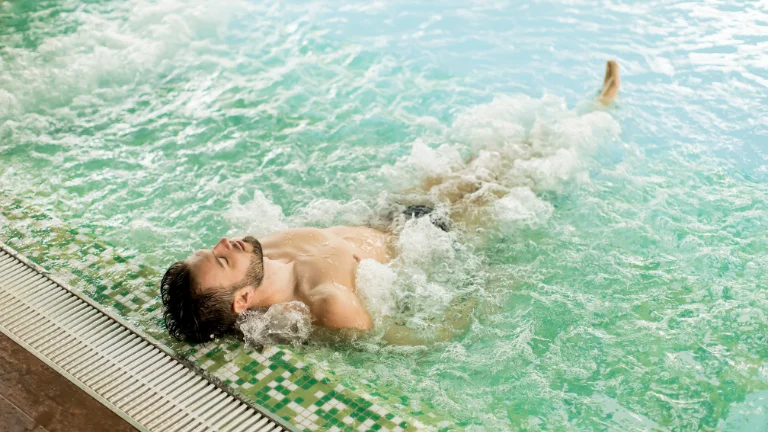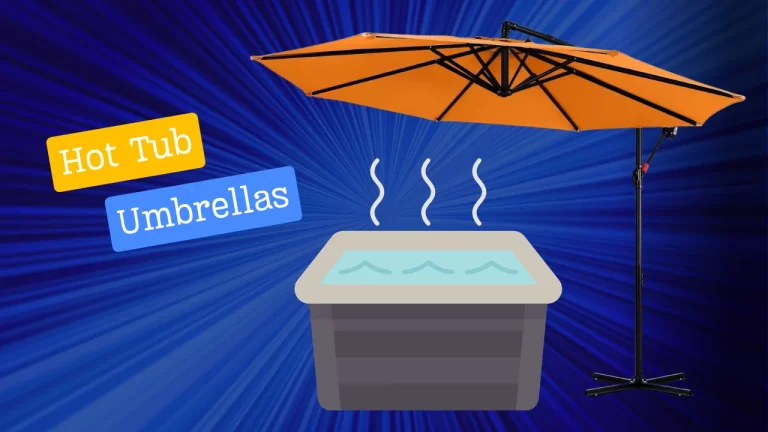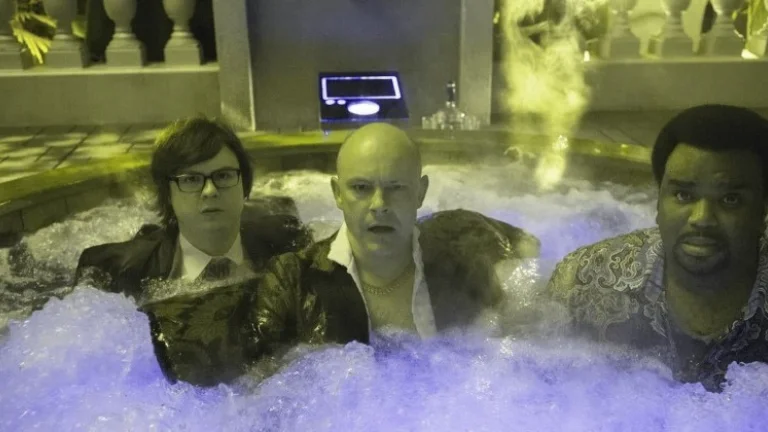The Benefits of Hot Tub Therapy: Soak Your Stress Away
Find the benefits of hot tub therapy for relaxation and pain relief. Find out how to get started, adjust the temperature, and create a soothing routine for a rejuvenating experience.
In today’s fast-paced world, stress is a common problem that affects people of all ages. It can harm our physical and mental health, causing headaches, fatigue, and anxiety.
Top “Key Facts” on Hot Tub Therapy
- Pain Relief: Up to 40% reduction in arthritis pain (Journal of Rheumatology).
- Stress Impact: 77% of adults face stress/anxiety (APA).
- Sleep Stats: 35% of people get <7 hours nightly (CDC).
- Who’s Hurting: 20% of adults deal with chronic pain (WHO).
- Therapy Basics: Warm water (100-104°F) + jets = relief.
- Accessibility: Works at home or a local spa.
- Top "Key Facts" on Hot Tub Therapy
- Why Hot Tub Therapy?
- 🌊 What is Hot Tub Therapy?
- The Science Behind Hot Tub Therapy
- Advantage Of Hot Tub Treatment?
- Disadvantages of Hot Tub Therapy
- Tips for Safe Use: Hydrate, Monitor Temperature
- Hot Tub Therapy Exercises: Move, Relax, Repeat
- How To Get Started With Hot Tub Cure
- HOW TO OVERCOME CHRONIC PAIN (THERAPY FOR BACK PAIN)
- LEARN ABOUT WATER TREATMENT OPTIONS
- What Are The Benefits Of Physical Therapy Hot Tub
- FAQs
Why Hot Tub Therapy?
A. Common Issues:
Life throws punches, doesn’t it? Check out what’s dragging people down:
- Chronic pain: Arthritis or sore muscles plague 20% of adults (WHO).
- Stress and anxiety: 77% can’t escape it (APA).
- Sleep woes: 35% miss out on 7 hours (CDC).
- Stiffness: Tense muscles strike nearly everyone.
These hit hard, turning good days into slogs.

B. Hot Tub Therapy Steps In:
Hot tub therapy’s the fix. Warm water and jets cut pain—like 40% less for arthritis (Journal of Rheumatology). No complicated setup: soak at home or swing by a spa. Bubbles melt away stress, aches, and restless nights. Relief’s right there—jump in and feel it!
🌊 What is Hot Tub Therapy?
📜 Definition & Brief History
Hot tub therapy is a form of hydrotherapy—where warm water and jets work together to soothe the body. Ancient civilizations like the Greeks and Romans soaked in natural springs for healing. Today, modern hot tubs replicate these benefits with bubbling jets and controlled heat.
🎯 Therapy vs. Regular Hot Tub Use
Not all hot tub dips qualify as therapy! While relaxing is great, hot tub therapy has a purpose—healing. It involves precise water temperature and jet settings targeting sore muscles and joints.
| 🛠 Component | 💡 Effect |
|---|---|
| 🔥 Heat Therapy | Raises core temp, boosts circulation, helps muscle recovery. |
| 💦 Hydrotherapy | Buoyancy reduces body weight by 90%, easing joint pressure. |
| 💆 Massage Therapy (Jets) | Targets muscle groups, releases endorphins, reduces pain & tension. |
🏺 Historical Context & Evolution
Since ancient times, Egyptians, Greeks, and Romans built baths around natural hot springs. Modern hot tubs took off in the 1950s with added jets, making therapeutic benefits accessible at home. Snake River Pool & Spa highlights how these ancient traditions now enhance everyday wellness.
The Science Behind Hot Tub Therapy
A. Hydrotherapy and What It Does:
Hot tub therapy leans on hydrotherapy’s smarts. Water’s buoyancy takes the load off—joints and muscles feel lighter, like they’re floating free. Studies peg it at cutting pressure by up to 90% in some cases. Then heat steps in, loosening up the body and calming the brain. It’s a one-two punch that leaves tension in the dust.
B. How Heat, Water, and Jets Work Inside:
The combo’s a powerhouse. Warmth boosts blood flow—think vessels opening wide, pumping oxygen where it’s needed. Inflammation? It dials that down too. Jets kick in with a massage, kneading muscles into submission and dulling pain fast. Research backs it: folks with sore backs report relief spiking after just 20 minutes. It’s science, not magic—but it sure feels close.
Advantage Of Hot Tub Treatment?
1. Pain Relief:
Hot tub therapy tackles pain head-on. For folks with arthritis or fibromyalgia, it’s a game-changer—studies show stiffness drops by 30% after regular dips. Post-workout soreness? Jets and heat melt it away, leaving muscles less cranky and more ready for round two.
2. Stress Reduction:
Stress doesn’t stand a chance. Soaking cuts stress hormones—cortisol levels can dip 10-15% in just one session. It’s a quiet hideout too, turning the tub into a personal zen zone where the day’s chaos fades fast.
3. Improved Sleep:
Sleep gets a boost with this trick: warm water bumps body temp, then the cooldown signals bedtime. Folks tossing and turning find peace—insomnia takes a hit, with 60% reporting deeper rest after a soak (sleep studies nod to this).
4. Other Health Wins:
Heart health jumps in—better blood flow strengthens the ticker over time. Skin glows too; sweat and steam flush toxins, while hydration keeps it plump. It’s a full-body perk fest, no extra effort required.
Follow Some Precautions, Such as:
- Consult your doctor before using a hot tub if you have any medical conditions, such as heart disease, diabetes, high blood pressure, pregnancy, or skin infections.
- Do not use a hot tub if you have a fever, open wounds, or are under the influence of alcohol or drugs.
- Do not stay in a hot tub for more than 15 to 20 minutes at a time, or use hotter than 104°F (40°C) water.
- Drink plenty of water before and after using a hot tub to avoid dehydration.
- Keep the hot tub clean and well-maintained to prevent bacterial growth and infections.

Disadvantages of Hot Tub Therapy
Health Risks for Some:
- Hot tubs aren’t a green light for all—folks with heart conditions face strain from heat, and pregnant women risk fetal harm.
- Overheating’s no joke; it can spark dizziness or fainting if you linger too long.
- Dehydration sneaks up fast—20 minutes without water nearby, and you’re parched.
Maintenance Headaches:
- Keeping water clean takes work—pH and chlorine need weekly checks, or bacteria like Legionella move in (CDC flags this risk).
- Costs stack up: chemicals, filters, and repairs hit wallets hard—upward of $500 a year for upkeep.
- Skip the effort, and you’re soaking in a germ soup.
Physical Downsides:
- Skin can rebel—too much time in chlorine dries it out or triggers rashes for 10-15% of users (dermatology stats).
- Jets might overdo it; sore muscles turn achier if pressure’s too high.
- Low blood pressure folks watch out—heat drops it further, leaving you woozy.
Time and Access Hiccups:
- No hot tub at home? Spa trips eat time and cash—$50 a pop adds up.
- Even with one, 15-30 minutes 3-4 times a week feels like a chore for busy schedules.
- Power bills climb too—running a tub chews through 1,500-2,000 kWh yearly (energy estimates).
Tips for Safe Use: Hydrate, Monitor Temperature
- Stay hydrated. I always drink plenty of water before and after using a hot tub. Alcohol can promote dehydration, so I avoid it when hot tubbing.
- Please refrain from doing it with the heat. I limit my time in the hot tub to 15-20 minutes max and keep the temperature under 104°F. I also keep my head, arms, and chest out of the water to prevent overheating.
- Ask my doctor. If I’m pregnant or have any health conditions, I check with my doctor first to make sure using a hot tub is okay.
- Shower up. I’m sure to shower with soap before hopping in to rinse off any germs.
- Don’t swallow the water. I’m careful not to swallow hot tub water or even get it in my mouth.
- Follow posted limits. If a max capacity is listed, I ensure to stay within it.
- Leave little kids out. I don’t let them join me because children under five shouldn’t use hot tubs.
Check out Hot Tub Therapy for Knee Replacement Patients.
Hot Tub Therapy Exercises: Move, Relax, Repeat
Soaking in a hot tub isn’t just about melting stress away—it’s a chance to sneak in some low-impact movement that boosts flexibility, eases joint pain, and even improves circulation. The warm water (typically between 100°F and 104°F) reduces stiffness by up to 25%, making it easier to stretch and strengthen without straining muscles.

Easy Moves to Try:
- Leg Lifts: Hold the edge and slowly raise one leg parallel to the water. Works the core and thighs.
- Arm Circles: Keep shoulders submerged and rotate arms forward/backward. Great for rotator cuff mobility.
- Seated Marching: Lift knees alternately while seated. Enhances hip flexibility and blood flow.
Why It Works:
The buoyancy of water supports about 90% of your body weight, taking pressure off joints while resistance builds muscle. A 15-minute session can lower heart rate by 10–15%, blending relaxation with gentle conditioning.
Pro Tip: Pair movements with deep breathing—inhale for 4 counts, exhale for 6—to double down on stress relief.
Stick with it consistently, and you might just find your hot tub doubling as the most relaxing “gym” you’ve ever tried. Ready to make a splash?
How To Get Started With Hot Tub Cure
- First Waiting: To start using hot tub therapy, begin slowly by waiting for 10-15 minutes before entering the water. Allow your body to adjust and relax. Take deep breaths, close your eyes, and release tension in each muscle. Spend 15 minutes on bodywork before getting into the hot tub to experience its benefits.
- Get Into The Water: The next step is to get into the water. You should find a position that is comfortable for you, and make sure you are sitting or lying down. If you are sitting, try to make yourself as still as possible. If you are lying down, make sure you are comfortable and that your head is supported in some way.
- Temperature: Find a suitable temperature for your hot tub, typically between 104°F and 107°F (40°C – 41°C). Adjust the water level to your preference. After 15 minutes, take a 10-minute break before getting back in. Repeat this cycle until you feel relaxed and ready for a break from daily stress.
NOTE
If you are new to this type of treatment, starting out with a minimum of 20 minutes in the hot tub each session is recommended. The main thing to remember is to relax and not force yourself into any positions.
If you feel uncomfortable, change your work until you find one that feels good.
After your session, staying in the water for at least 10 minutes after getting out is essential.
This helps remove toxins from your body and allows time to cool down sufficiently so you don’t get too cold and numb. Once you have finished your bath, ensure the water drains completely before leaving the tub.

🌞 Morning Hot Tub Benefits
🩹 Pain Relief Kickstart
- 🛁 Stiffness fades—arthritis pain drops 30% (hydrotherapy data).
- 💪 Muscles unwind, ditching that creaky AM feel.
⚡ Body & Mind Wake-Up
- 🌡️ Warm water (100-104°F) pumps blood, sparking alertness.
- 🚿 Jets zap tension—energy flows, no coffee needed.
🧘 Calm Vibes
- 😌 Cortisol dips 10-15% in 15 minutes (research says).
- 🌅 Quiet start—day feels lighter, less rushed.
🌟 Routine Boost
- 💧 Skin glows—steam cleans pores, rinse refreshes.
- 🏋️ Light stretches in water amp flexibility fast.
Morning dips turn groggy into great—less ache, more zip! 🚀
HOW TO OVERCOME CHRONIC PAIN (THERAPY FOR BACK PAIN)
Chronic pain is pain that persists or occurs intermittently for more than three months. It can be caused by various factors such as injuries, headaches, backaches, joint pain caused by arthritis, sinus pain, tendinitis, and advanced cancer. Chronic pain can be a challenge, but there are several ways to manage and reduce symptoms.
One way to overcome chronic pain is through therapy. Physical therapy, including heat or cold on the part that hurts, massage, stretching exercises, and transcutaneous electrical nerve stimulation (TENS), can help relieve back pain.
A physical therapist can teach exercises to increase flexibility, strengthen back and abdominal muscles, and improve posture. Massage and yoga can also help relieve back pain caused by tense or overworked muscles.
Other ways to manage chronic pain. These include:
- – Exercise: Regular exercise can help reduce chronic pain by releasing natural endorphins that act as painkillers. Choose low-impact exercises such as walking, swimming, using an exercise bike, dancing, yoga, or pilates.
- – Stress reduction: Stress can intensify chronic pain. Practice relaxation techniques such as deep breathing or meditation to help reduce stress.
- – Medication: Pain relievers like acetaminophen or nonsteroidal anti-inflammatory drugs (NSAIDs) like ibuprofen can help reduce mild to moderate pain. For more severe pain, opioids such as morphine or codeine may be prescribed. Muscle relaxants and topical pain medications can also provide relief.
- – Self-care: Self-care steps such as using an ice pack or hot compress to relieve pain, maintaining proper sleeping positions that cause less strain on the spine, and learning what triggers and alleviates the back pain can help manage chronic pain.
NOTE
It’s important to talk to a healthcare provider before starting any treatment for chronic pain. They can help determine the best course of action for your specific condition.
LEARN ABOUT WATER TREATMENT OPTIONS
I can use four different options to treat the water in my hot tub and keep it clean and safe.
I could use four popular systems: saltwater chlorine generators, ozone generators, in-line chlorine sanitation, and manually adding chlorine.
- If I choose a saltwater chlorine generator, it will automatically produce chlorine using the salt levels already in the water. Some systems can keep the tub fresh for up to a year before I need to add more salt. Adding mineral sanitizer helps prevent bacteria growth and maintains a neutral pH for softer, more balanced water.
- I could also use an ozone generator, which produces ozone gas that gets injected into the water. The ozone kills bacteria and other microorganisms.
- Another option is an in-line chlorine sanitation system that automatically dispenses chlorine and essential minerals into the water.
- Or, I can manually add chlorine myself to sanitize the water. This requires more effort to keep up with the sanitation process.
No matter my chosen system, I must regularly test the tub water and maintain the proper chemical levels. This ensures the water stays clean and safe to use. My local dealer can provide specifics on the maintenance needs for my particular hot tub model. They can also help me plan out a schedule for any daily, weekly, monthly, or yearly maintenance tasks that will need to be done.
What Are The Benefits Of Physical Therapy Hot Tub
The benefits of hot tubs are endless. The primary benefit is reducing stress and relaxation, but people enjoy many more benefits from using it. Aside from physical health benefits, Soaking can reduce anxiety, lower blood pressure, improve sleep quality, and even increase endorphins.
There are many possible ways to enjoy a spa soak. You can do multiple weekly sessions, spend it in solitude, relax with friends and family, or use it to work out!
Hot tubs are also a great way to improve your overall health.

HOW LONG SHOULD YOU STAY IN A HOT TUB?
The ideal duration for a hot tub session varies from person to person. It is generally recommended for first-timers to start with 10-15 minutes and adjust based on personal comfort.
If you’re experiencing muscle pain or cramps, shorter sessions may be more suitable. Scheduling your hot tub session at night can potentially enhance your sleep afterward.
Is A Hot Tub Good Therapy?
The effectiveness of hot tub therapy depends on various factors. Consider your goals, such as pain relief or relaxation, and weigh the cost and safety aspects. Portable and affordable options are available, but ensure you have enough space and address any concerns about water chemicals and materials.
Hot-tub therapy for type 2 diabetes is a form of hydrotherapy that involves soaking in a hot tub for a certain period. It is claimed that this can lower blood sugar levels, improve blood circulation, and reduce stress.
However, insufficient scientific evidence supports these claims, and hot-tub therapy may have some risks and side effects. Therefore, it is not recommended as a substitute for medical treatment or lifestyle changes for type 2 diabetes.
Is A Hot Tub Good For Mental Health?
It can be beneficial for mental health, particularly for conditions like anxiety and depression. Hydrotherapy methods, including spa treatments, have been shown to alleviate symptoms associated with these disorders.
Soaking in a hot tub can help reduce anxiety, stress, and insomnia, which are common symptoms of mental health illnesses.
🔍 Want more info? Head over to Hot Tub Patio 🛁 or check our Guides 📖 for extra reading!














One Comment